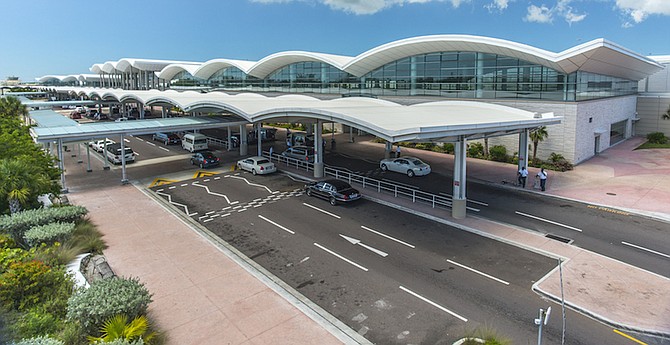By NEIL HARTNELL
Tribune Business Editor
nhartnell@tribunemedia.net
Major Nassau/Paradise Island resorts suffered a 28 percent room revenue fall for the 2020 first quarter just before COVID-19 unleashed its full fury with only 445 passengers exiting The Bahamas’ major airport during April.
The Central Bank of The Bahamas, unveiling its monthly economic report for April, gave a first insight into the pandemic’s impact on the country’s top industry and foreign exchange earner by revealing that international departures through Lynden Pindling International Airport (LPIA) shrank by almost 100 percent - some 160,000 - after the country’s borders were closed.
“Data provided by the Nassau Airport Development Company (NAD) revealed that during the month of April, total international departures contracted to a mere 445, relative to the prior year’s 18.3 percent growth to 160,275,” the Central Bank said.
“In the previous year, the expansion was broad-based with US and non-US bound departures strengthening by 21.3 percent and by 2.8 percent, respectively. Over the first four months of the year, outward bound traffic reduced by 33 percent, a turnaround from a 21 percent increase in the preceding year.
“By region, the dominant US component fell by 37.9 percent after growing by 23.1 percent last year. In addition, the non-US international component declined by 33.2 percent, overturning the 10.4 percent gain in 2019.”
The sharp drop-off in tourism arrivals and business in March, normally the peak month for industry activity, also dragged down Nassau/PI hotel industry performance for the 2020 first quarter. “Data from The Bahamas Hotel & Tourism Association (BHTA) and the Ministry of Tourism confirmed the deterioration in hotel sector performance,” the Central Bank noted.
“In March, the average hotel occupancy rate declined significantly to 41.8 percent from 86.7 percent in the same period last year. The number of room nights sold contracted by 56.3 percent, while the average daily room rate (ADR) reduced by 15.5 percent to $300.20, resulting in a 59 percent fall-off in room revenues.
“Over the three-month period, the occupancy rate fell by 14.8 percentage points to 63.2 percent, as the number of room nights sold decreased by 21 percent. In addition, the ADR moved lower by 9.3 percent to $273.57, with room revenue declining by 28 percent.” The Bahamian tourism industry was completely shutdown for the final two weeks in March as a result of the COVID-19 emergency, with arrivals impacted from earlier in the month.
“With regard to the vacation rental market, data provided by AirDNA for the month of April showed a 59.4 percent fall-off in total room nights sold, underpinned by contractions in bookings for entire place listings and hotel comparable listings, of 60.1 percent and 52.1 percent, respectively,” the Central Bank added.
“Conversely, the average daily room rate (ADR) for entire place listings and hotel comparable listings firmed, by 5.1 percent and by 3.8 percent, to $427.77 and $166.16, respectively. On a year-to-date basis, total room nights sold fell by 7.9 percent, as the 9.7 percent reduction in bookings for entire place listings overshadowed the 8.3 percent gain in bookings of hotel comparable listings.
“Similarly, the ADR for hotel comparable and entire place listings decreased by 4 percent to $155.16, and by 0.9 percent to $394.50, respectively.”
As for arrivals figures, the Central Bank added: “Total visitor arrivals reduced by 59.7 percent in March, a reversal from a 5.9 percent growth during the same period in 2019. Underlying this outturn, the high value-added air segment fell by 62.5 percent, a turnaround from the 9.5 percent gain a year earlier. Similarly, the dominant sea component declined by 58.6 percent, vis-à-vis a 4.6 percent increase last year.
“A breakdown by major port of entry revealed broad-based declines across the major markets. Specifically, total visitors to New Providence contracted markedly by 64.6 percent, contrasting with the 20.9 percent growth in the prior year, as both the sea and air components fell, by 66.7 percent and 60.2 percent, respectively.
“Similarly, underpinned by reductions in both air (74 percent) and sea (65.9 percent) traffic, total arrivals to Grand Bahama decreased sharply by 66.9 percent, extending the 1.7 percent downturn recorded in the previous year. Likewise, visitors to the Family Islands reduced by 46 percent, exceeding the 6 percent falloff in 2019, amid respective declines in the air (68.9 percent) and sea (40.3 percent) segments.
“March’s adjustments also contracted tourism for the first quarter, as arrivals fell by 14.7 percent, a turnaround from a 12.3 percent expansion in the previous year, attributed to respective reductions in the air and sea components, of 28 percent, and 10.5 percent.”





Comments
Use the comment form below to begin a discussion about this content.
Sign in to comment
Or login with:
OpenID